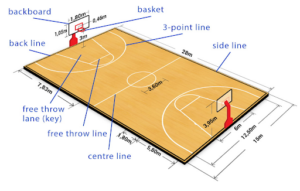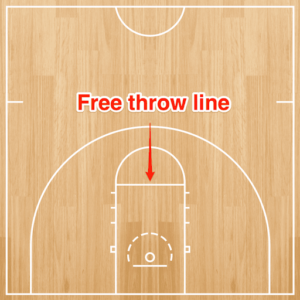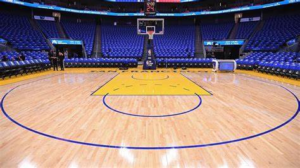Whether you’re a player, coach, or a fan, understanding the basketball court is important. The court itself is the stage where all the action takes place, and every line, mark, and area has a specific purpose. In this guide, we’ll break down the basketball court, helping you understand the function of each part and how it impacts the game.
By the end of this breakdown, you’ll have a full grasp of the court’s layout and how each section plays a role in strategy, positioning, and gameplay.

The Dimensions: Setting the Stage
Before diving into specific sections, it’s important to understand the overall size of the basketball court. While the exact dimensions can vary slightly depending on the level of play (NBA, college, FIBA, etc.), the standard court size for most professional and collegiate games is:
- Length: 94 feet (28.65 meters)
- Width: 50 feet (15.24 meters)
For high school basketball, the court is slightly smaller at 84 feet long and 50 feet wide. These dimensions are essential because they dictate spacing, ball movement, and positioning during the game.
The Baseline and Sidelines: Defining the Boundaries
The baseline and sidelines are the outer boundaries of the court. These lines play a role in determining possession and spacing.
- Baseline (Endline): The lines running along the short ends of the court behind the baskets. When the ball crosses this line, it is considered out of bounds.
- Sidelines: The two long boundary lines running the length of the court. Similar to the baseline, the ball is out of bounds if it crosses the sideline.
Center Court and Half-Court Line: The Midpoint of Play
At the very center of the basketball court is the center circle, which is used at the start of the game for the tip-off. It’s a vital area at the beginning of the game but doesn’t play a huge role once the action begins.
- Center Circle: This 12-foot diameter circle is where the game begins. During a tip-off, one player from each team jumps to try and gain control of the ball.
- Half-Court Line: The line dividing the court into two equal halves. Once a team crosses this line while on offense, they cannot go back across it without committing a backcourt violation.
Key (Paint): The Power Zone
The key, also known as the paint, is the rectangular area under the basket. This is one of the most important areas on the court, particularly for big men and post players. It’s the main spot for offensive and defensive action close to the basket.
- Dimensions: The key is 16 feet wide in the NBA and 12 feet wide in most other leagues. It stretches from the baseline to the free-throw line.
- Three-Second Rule: Offensive players are not allowed to stay in the key for more than three seconds at a time without the ball, or they’ll commit a violation known as a three-second violation.
Within the key, players must fight through tight spaces and tough defenses to score close to the basket. Defensively, it’s the area where many blocks, charges, and rebounds happen.
The Free-Throw Line and Circle: Foul Shot Territory
The free-throw line is located at the top of the key and is used for free throws after a foul. Understanding this area is crucial, as free throws can be the difference between winning and losing a game.
- Distance: The free-throw line is 15 feet away from the backboard.
- Free-Throw Circle: This is the 6-foot radius circle around the free-throw line. Players must stay outside of this circle until the shooter releases the ball during free throws.
Mastering free throws from this spot is essential for all players, as they are one of the easiest ways to score uncontested points.

The Three-Point Line: From Long Distance
The three-point line is one of the most important lines on the court, especially in today’s basketball, where shooting from long range has become a strong strategy. Any shot taken from beyond this arc is worth three points instead of the standard two.
- NBA Distance: In the NBA, the three-point line is 23.75 feet from the basket at its farthest point (the top of the arc) and 22 feet at the corners.
- College and High School: The distance is slightly shorter, at 22.1 feet for NCAA basketball and 19.75 feet for high school games.
The ability to hit shots consistently from beyond this line is a valuable skill, opening up offensive options and spreading out the defense.

The Restricted Area: Protecting the Rim
The restricted area is a semi-circular zone beneath the basket. This zone is crucial for defensive strategy and helps protect players driving to the basket from dangerous collisions.
- Diameter: The restricted area has a 4-foot radius.
- Blocking and Charging: A defender cannot establish position within this area to take a charge. If they do, it results in a blocking foul, not an offensive foul. This rule is meant to encourage more open play near the rim and reduce injuries from players colliding into stationary defenders.
The Low Post and High Post: Prime Scoring Areas
The low post and high post are two critical areas around the key where post players do most of their work.
- Low Post: This area is located near the basket along the sides of the key. Players in the low post typically score with layups, dunks, or short hook shots.
- High Post: Located near the free-throw line, the high post is where big men often receive the ball to shoot mid-range jumpers or pass to cutters.
These areas are vital for establishing offensive plays, with players using their size and strength to gain positioning for scoring opportunities.
The Corners: The Sweet Spot for Three-Pointers
The corners of the basketball court are prime locations for shooting three-pointers, as they are the shortest distance from the basket. Known as the corner three, it’s a high-efficiency shot that many players and teams focus on during games.
The Perimeter: Guard Territory
The perimeter refers to the area outside the key but inside the three-point line. Guards and smaller forwards typically operate in this space, where they can take mid-range jumpers, drive to the basket, or pass the ball to teammates. A lot of ball movement happens on the perimeter, making it a critical area for creating open shots.
Basket and Backboard: The Target
At the heart of the court is the basket, consisting of a hoop (or rim) and a backboard. The basket is 10 feet off the ground in all levels of play, making it the ultimate target for every player on the court.
- Backboard: The rectangular board behind the hoop that players use to bank in shots.
- Rim: The 18-inch diameter metal hoop that the ball must pass through to score points.
Conclusion: Mastering the Court for Mastering the Game
Understanding the basketball court is fundamental to improving your game. Each part of the court plays a crucial role in both offensive and defensive strategies, and knowing how to navigate these spaces will make you a smarter, more effective player.
Whether you’re working on your post moves in the paint, perfecting your three-point shot from beyond the arc, or defending the restricted area, mastering the court’s layout is key to mastering the game. By breaking down each section of the court and how it influences the game, you can elevate your basketball IQ and make better decisions on the floor.
FAQs
Q: How far is the three-point line in the NBA?
A: In the NBA, the three-point line is 23.75 feet from the basket at the top of the arc and 22 feet from the corners.
Q: What is the restricted area in basketball?
A: The restricted area is a 4-foot radius semi-circle under the basket where defenders cannot take a charge, encouraging more open play near the rim.
Q: What’s the difference between the low post and high post?
A: The low post is located near the basket, where players typically score with close-range shots. The high post is near the free-throw line, where players can shoot mid-range jumpers or pass to cutters.
Subscribe to Basketball Fundamentals for more breakdowns, tips, and drills to improve your game and understanding of the court!